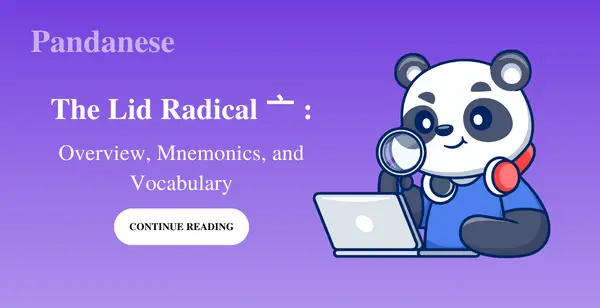
The Lid Radical 亠 : Overview, Mnemonics, and Vocabulary
In this article, we’ll introduce you to the lid radical 亠, how to learn it with fun mnemonics, and a list of vocabulary associated with this radical.
Continue reading for this useful information!
What is the lid radical?

In Chinese, the lid radical is pronounced as “tóu” and written as 亠. The Chinese lid radical has two strokes and is listed as radical 8 according to the Kangxi radical chart (a system of radicals of Chinese characters).
Similar looking radicals to 亠 include 一 yī (one), 厂 hǎn (cliff), or 目 mù (eye), which illustrate the object one character describes, the lid radical 亠 also shows how the character and the object they describe are closely related. The lid radical hasn’t changed so much through time; let’s have a look at its historical form.
What is the stroke order of the lid radical?
The lid radical has two strokes, written in the following order:

亠 radical stroke order
How can you memorize the lid radical?
Though it’s not difficult to commit the lid radical 亠 to memory, there’s a learning technique that lets learners memorize this character with fun rather than learn it by heart—the mnemonics technique.
No need to make it complicated. For one thing, 亠 looks like a lid! An easy mnemonic for you to remember.
A lid radical vocabulary list for you!
Want to explore more about the lid radical? Here’s a list of some of the most essential Hanzi that contain the lid radical:
Character |
Pinyin |
English meaning |
亮 |
liàng |
bright, to reveal |
亦 |
yì |
also |
亢 |
kàng |
high, excessive |
市 |
shì |
city |
夜 |
yè |
night |
校 |
xiào |
school |
高 |
gāo |
tall |
抗 |
kàng |
to fight |
卒 |
zú |
at last |
坑 |
kēng |
hole, pit |
To summarize
Nothing too complex with the Chinese lid radical 亠. There’s no direct translation 亠 radical, but an important and common radical you will see in Chinese characters.
The easiest way to learn Chinese & build vocabulary

